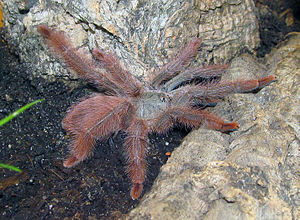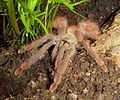Pseudoclamoris gigas
| Pseudoclamoris gigas | ||||||||||||
|---|---|---|---|---|---|---|---|---|---|---|---|---|

Pseudoclamoris gigas , juvenile female |
||||||||||||
| Systematics | ||||||||||||
|
||||||||||||
| Scientific name | ||||||||||||
| Pseudoclamoris gigas | ||||||||||||
| ( Caporiacco , 1954) |
Pseudoclamoris gigas ( Syn . : Tapinauchenius gigas ) is a tree-dwelling tarantula species that was discovered in 1913 in Saint-Jean-du-Maroni , Guyana . The female wasdescribedby Lodovico di Caporiacco asearly as 1954. The male of this species wasdescribedby Günter Schmidt only 40 years later. Pseudoclamoris gigas is one of the more common terrarium species of tarantulas.
features
The holotype is 4.6 inches long (measured from the bite claws to the spinnerets). The carapace measures 1.9 centimeters and is red-brown in color. The biting claws are dark in color. The hair on the labium and maxilla is red. The sternum and the coxae of the buttons and the two front legs are colored black-brown. The coxae of the two rear legs are hairy brown-yellow. The tarsi of the buttons are red-brown and the adhesive pads are brown-yellow. The abdomen is yellow-brown in color.
The nymphs are colored orange and have a fir tree-shaped pattern on their opisthosoma. They differ in color from the blue-gray nymphs of the related Pseudoclamoris elenae . From the fifth scavenger skin onwards, both types look the same and can no longer be distinguished by their color in the adult stage.
behavior
The mating is mostly peaceful. The female can produce a cocoon the size of a table tennis ball just a week later. There are 100 to 400 eggs in it. Sometimes the female attaches the cocoon to a thread and hangs it up on a wall in its living tube. The hatched larvae are taken care of by the mother. They are very likely to be able to feed themselves with their prey. It has already been observed that the mother covers the larvae with a little spider silk in order to protect them very likely from falling. Young animals that are left with their mother grow larger in captivity than when raised separately. Similar to some Psalmopoeus species, if there is enough food, females often build a second cocoon without re-mating, but this cocoon contains about twenty eggs less than the first.
In the event of disturbance, the animals flee as quickly as possible into their living tube or into a closer shelter. In captivity it was observed several times that some animals withdrew into the drinking vessel filled with water and completely submerged for up to five minutes.
Pseudoclamoris gigas , juvenile female eating a desert locust
Individual evidence
- ↑ a b Lodovico di Caporiacco: Araignées de la Guyane Française du Muséum d'Histoire Naturelle de Paris. In: Commentat. pontif. Acad. Scient. 16: 45-193. 1954.
- ↑ a b c d Hans Werner Auer, Martin Huber, Armin Bochtler: The genus Tapinauchenius Ausserer, 1871 in portrait . In: Arachne 12 (2), 2007

